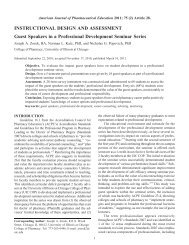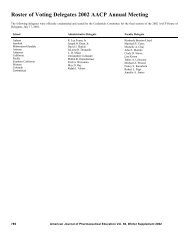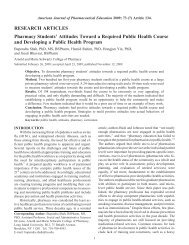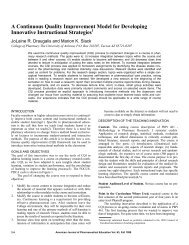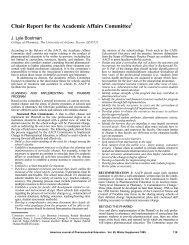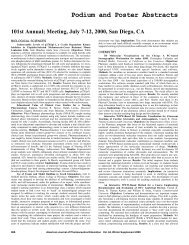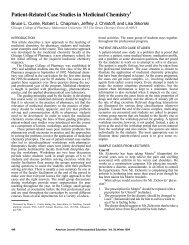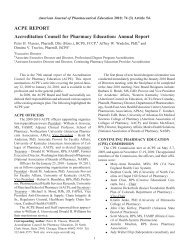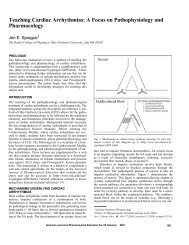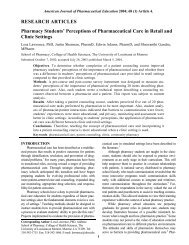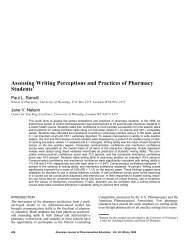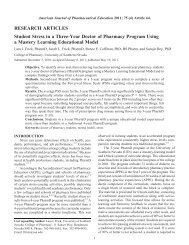TOPICS Role of Protein Binding in Pharmacokinetics - AJPE
TOPICS Role of Protein Binding in Pharmacokinetics - AJPE
TOPICS Role of Protein Binding in Pharmacokinetics - AJPE
Create successful ePaper yourself
Turn your PDF publications into a flip-book with our unique Google optimized e-Paper software.
American Journal <strong>of</strong> Pharmaceutical Education 2005; 69 (5) Article 103.<br />
Table 1. Major Drug <strong>B<strong>in</strong>d<strong>in</strong>g</strong> <strong>Prote<strong>in</strong></strong>s <strong>in</strong> Plasma 4,7 Normal Concentration<br />
<strong>Prote<strong>in</strong></strong> MW, g/mole g/dL mM Type <strong>of</strong> Drugs Bound Example<br />
Album<strong>in</strong> 67,000 3.5-5 500-700 acidic, basic Warfar<strong>in</strong><br />
a 1 -Acid glycoprote<strong>in</strong> 42,000 0.04-0.1 9-23 basic, neutral Propranolol<br />
Lipoprote<strong>in</strong>s 200,000-2,400,000 Varies Varies lipophilic basic and neutral Cyclospor<strong>in</strong>e<br />
<strong>in</strong> the aff<strong>in</strong>ity for b<strong>in</strong>d<strong>in</strong>g to AAG can occur when one<br />
drug displaces the other from its b<strong>in</strong>d<strong>in</strong>g sites.<br />
Lipoprote<strong>in</strong>s, which consist <strong>of</strong> very low-density lipoprote<strong>in</strong>s,<br />
low-density lipoprote<strong>in</strong>s, and high-density<br />
lipoprote<strong>in</strong>s, are synthesized <strong>in</strong> the liver and <strong>in</strong>test<strong>in</strong>al<br />
mucosa, and their normal plasma concentrations are<br />
variable (,0.5 g/dL; Table 1). Usually, basic and neutral<br />
drugs with a high degree <strong>of</strong> lipophilicity are substantially<br />
bound to lipoprote<strong>in</strong>s. The concentrations <strong>of</strong><br />
lipoprote<strong>in</strong>s change <strong>in</strong> a variety <strong>of</strong> diseases such as renal<br />
failure, diabetes mellitus, hyperlipoprote<strong>in</strong>emia, and<br />
alcoholism. Examples <strong>of</strong> drugs significantly b<strong>in</strong>d<strong>in</strong>g to lipoprote<strong>in</strong>s<br />
are cyclospor<strong>in</strong>e, 9 tacrolimus, 10 and prop<strong>of</strong>ol. 11<br />
Blood Versus Plasma<br />
The pharmacok<strong>in</strong>etic parameters <strong>of</strong> drugs are usually<br />
estimated after measurement <strong>of</strong> drugs <strong>in</strong> plasma rather<br />
than whole blood. However, the relationships between<br />
major pharmacok<strong>in</strong>etic parameters (such as volume <strong>of</strong><br />
distribution or clearance) and their physiological determ<strong>in</strong>ants<br />
(such as perfusion or prote<strong>in</strong> b<strong>in</strong>d<strong>in</strong>g) are based<br />
on the value <strong>of</strong> these parameters <strong>in</strong> blood. If the blood:<br />
plasma concentration ratio <strong>of</strong> a drug is equal to 1, the<br />
k<strong>in</strong>etic parameters obta<strong>in</strong>ed us<strong>in</strong>g the plasma and blood<br />
will be identical. Additionally, for drugs with a blood to<br />
plasma ratio different than 1, the plasma concentrations<br />
may be easily converted to the respective blood values if<br />
the blood to plasma ratio is known. Unfortunately, most<br />
reports <strong>in</strong> the literature use blood and plasma k<strong>in</strong>etic<br />
values <strong>in</strong>terchangeably, even if it is not shown that the<br />
blood to plasma ratio is equal to 1. In the follow<strong>in</strong>g<br />
section, we will base our discussion on blood data and<br />
provide alternative relationships, if they exist, for the<br />
plasma data. For simplicity, when literature examples<br />
are used to demonstrate concepts, we assume a blood<br />
to plasma ratio <strong>of</strong> 1.<br />
How Does <strong>Prote<strong>in</strong></strong> <strong>B<strong>in</strong>d<strong>in</strong>g</strong> Affect Major<br />
Pharmacok<strong>in</strong>etic Parameters?<br />
Volume <strong>of</strong> distribution. The volume <strong>of</strong> distribution<br />
at steady state (V SS ) may be def<strong>in</strong>ed by the follow<strong>in</strong>g<br />
equation 3 :<br />
<br />
V SS 5 V B 1<br />
f <br />
ub<br />
V T<br />
ð1Þ<br />
f ut<br />
3<br />
where V B and V T are the volume <strong>of</strong> blood and tissue<br />
(extravascular space), and f ub and f ut are the unbound<br />
fractions <strong>in</strong> the blood and tissue, respectively. V B is<br />
~0.07 L/kg or 5 L/70 kg. V T is the real extravascular<br />
volume <strong>in</strong> which the drug is distributed. For lipophilic<br />
(non-polar) drugs, V T (~0.6 L/kg) is the total body water<br />
m<strong>in</strong>us the blood water volume, because these drugs distribute<br />
to both the extracellular and <strong>in</strong>tracellular spaces.<br />
The value <strong>of</strong> V T for hydrophilic (polar) drugs that do not<br />
penetrate <strong>in</strong>tracellular space is the volume <strong>of</strong> extracellular<br />
water m<strong>in</strong>us the plasma water volume (~0.13 L/kg). 5<br />
As mentioned above, the concentrations <strong>of</strong> drugs are<br />
mostly measured <strong>in</strong> plasma (<strong>in</strong>stead <strong>of</strong> whole blood), and<br />
free fractions are also estimated <strong>in</strong> plasma (f up ). However,<br />
if the blood:plasma concentration ratio <strong>of</strong> the drug is<br />
known, f ub may be easily estimated from f up and blood<br />
to plasma ratio as demonstrated below:<br />
f ub 5 f up<br />
ð2Þ<br />
B:P<br />
In the absence <strong>of</strong> blood to plasma ratio, another parameter,<br />
V SS based on the plasma data (V9 SS ), may be<br />
estimated us<strong>in</strong>g the follow<strong>in</strong>g equation:<br />
<br />
VSS 0 5 V P 1<br />
f up<br />
f ut<br />
<br />
V 0 T<br />
ð3Þ<br />
where V9 SS is a proportionality constant relat<strong>in</strong>g the<br />
amount <strong>of</strong> drug <strong>in</strong> the body to the plasma concentrations<br />
(as opposed to blood concentration for V SS ). V9 T is different<br />
from V T <strong>in</strong> that it also conta<strong>in</strong>s the volume <strong>of</strong> red blood<br />
cells <strong>in</strong> addition to the extravascular space. 3 For drugs that<br />
are restricted to plasma (such as macromolecules), V P is<br />
equal to the volume <strong>of</strong> plasma (~3 L/70 kg). However,<br />
because plasma prote<strong>in</strong>s such as album<strong>in</strong> enter slowly <strong>in</strong>to<br />
the <strong>in</strong>terstitial fluid, at equilibrium V P may be larger than<br />
the volume <strong>of</strong> plasma (~7 L/70 kg or 0.10 L/kg) for small<br />
molecule drugs. 4<br />
As one may recognize from the above equations, V SS<br />
may differ significantly from V9 SS . However, most <strong>in</strong>vestigators<br />
use these 2 terms <strong>in</strong>terchangeably, which is correct<br />
only if the blood to plasma ratio is equal to unity.<br />
Conceptually, these equations predict a larger V SS (or<br />
V9 SS )iff ub (or f up ) is <strong>in</strong>creased and a lower V SS (or V9 SS )if<br />
f ut is <strong>in</strong>creased. This is understandable because a higher<br />
free fraction <strong>in</strong> blood/plasma results <strong>in</strong> a movement <strong>of</strong> the



